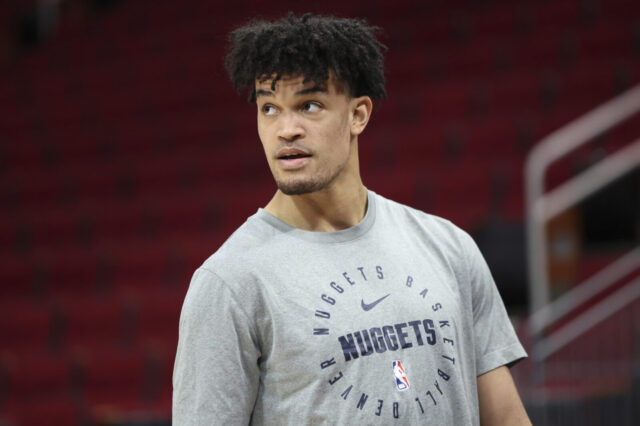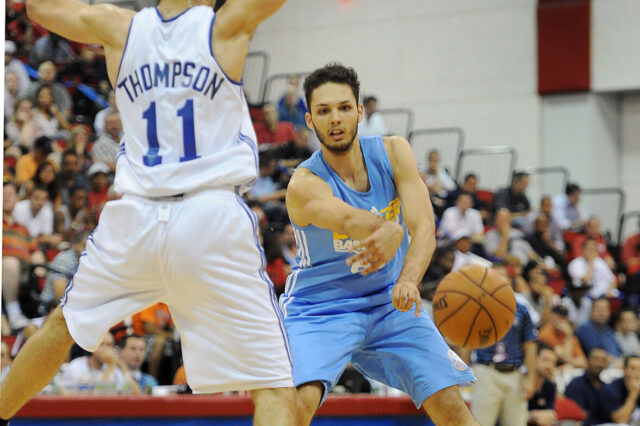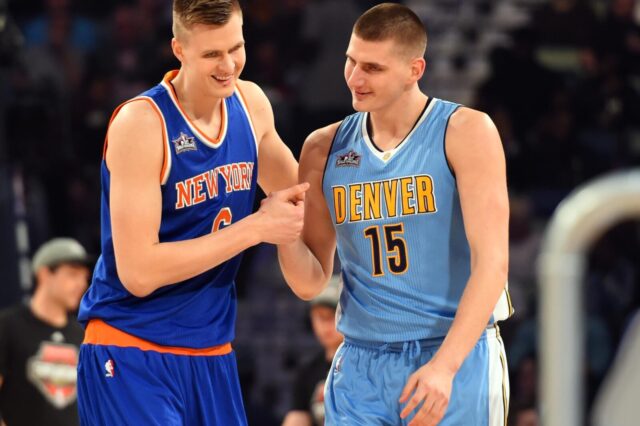I really like Jamal Murray and Buddy Hield, but I didn’t know how much I liked them until I did some research.
The premise for this article was spawned in a discussion about Jaylen Brown. A high caliber prospect, Brown has been the face of the non-shooters in the draft this year. He shot 29.4% from beyond the arc in college. That's not very good, but it's not so bad that people don't believe he can improve at all.
Projecting improvement from college age prospects can be dicey. Nobody can truly appreciate if a player will take steps forward unless they have conversations with the prospect in question. My colleague Jeff Morton was given great vibes from Wade Baldwin when he came in based off of his personality, character, and seemingly willingness to get better. That’s an excellent tidbit, one that was also received from Devin Booker the prior season, who was probably the fourth or fifth best rookie last year.
I don't pretend to have that kind of insight into that side of the game, but I do have history to look at. History is a great tool to utilize in predicting the likelihood of certain players being successful. It's not perfect, but generally similar players that put up similar numbers will have similar NBA outcomes, unless extenuating circumstances change that course.
I went back through the first round of the 2009 through 2013 drafts and identified shooting guards, small forwards, and power forwards who were designated as candidates to be jump shooters in the NBA. I left out point guards and centers because too often, point guards are asked to distribute and centers are asked to be paint bound, so it paints a different picture than I want.
In total, 80 players were considered from those five drafts for this exercise in order to have a solid sample size, all with varying percentages, attempts, and outcomes in the NBA. I will attempt to quantify certain aspects that are helpful in projecting what makes a solid shooting prospect.
There are outliers in this exercise, Kawhi Leonard at the head of it. He will be factored into the projections as well, along with other players who surprisingly became good shooters, in order to give guys like Jaylen Brown a shot.
Before I begin, here are some terms that I will consistently use throughout the article:
- Regression – the shooter gets worse from college to pro in his percentages by three percent or greater
- Neutral – the shooter stays within plus/minus three percent of his college percentages in the pros
- Progression – the shooter gets better from college to pro in his percentages by three percent or greater
- Success – the shooter fields a 35 percent mark or greater in the NBA
The player shot LESS than 30 percent in college or overseas (19 players total):
| Regression (-3%) | Neutral (-3% to +3%) | Progression (+3%) | Success (35%+) | |
| Players in category | 6/19 | 6/19 | 7/19 | 3/19 |
| % of players there | 31.6% | 31.6% | 38.8% | 15.8% |
Basically, this chart is telling us that it's very hard to improve as a shooter if the candidate starts as low as he does. The fact of the matter is that of the nineteen total players that were drafted in the first round of these drafts, only seven of them have shown more than a marginal increase. Furthermore, only three of those candidates improved their shooting enough to be a legitimate threat in the NBA at 35 percent or greater.
This doesn’t reflect very well on players who shot less than 30 percent over the course of their careers. It should be reasonably logical that these players won’t do well shooting in all likelihood, but it doesn’t mean they can’t be good players. The six players drafted in the top 10 that shot less than 30 percent from behind the arc are Blake Griffin, Tyreke Evans, DeMar DeRozan, Jan Vesely, Anthony Davis, and Michael Kidd-Gilchrist. None of those players shoot above 30 percent in the NBA from behind the arc, but five of the six turned out to be solid contributors or even stars.
Long story short, a player selected in the top 10 doesn't have to be a shooter to be successful, but don't draft him with the expectation of becoming a legitimate threat if he shoots less than 30 percent. The success rate of that is less than 16 percent.
The player shot MORE than 30 percent in college or overseas (61 players total):
| Regression (-3%) | Neutral (-3% to +3%) | Progression (+3%) | Success (35%+) | |
| Players in category | 28/61 | 28/61 | 5/61 | 22/61 |
| % of players there | 45.9% | 45.9% | 8.2% | 36.1% |
This may not seem to verify anything, but it does show that by drafting ANY shooter who shot greater than 30 percent in college, the success rate more than doubled. Anytime an executive hears "double the success rate" on a prospect, his ears will perk up very quickly. Nothing is guaranteed in the NBA, shooting especially, so if I say 22/61, it's a pretty big deal.
Let's see how the table changes when I up it to 35 percent:
The player shot MORE than 35 percent in college or overseas (36 players total):
| Regression (-3%) | Neutral (-3% to +3%) | Progression (+3%) | Success (35%+) | |
| Players in category | 23/36 | 11/36 | 2/36 | 15/36 |
| % of players there | 63.9% | 30.6% | 5.6% | 41.7% |
The success rate has gone up even higher from 36.1 percent to 41.7 percent, but the regression numbers have spiked massively as well. The two progression cases are three to four year players who were drafted within the first 11 picks. There’s also a player like that in the 2016 NBA Draft. More on him later.
I want to examine the regression cases for these players that were seemingly good shooters in college or overseas, but failed to be in the NBA. A good way to figure this out is examining the sample sizes of each of the 23 regression candidates. Comparing them to the neutral/progression group would be wise.
The player shot MORE than 35 percent in college or overseas, comparing the average three point attempts in college of each group (36 players total):
| Regression group (23) | Neutral/Progression group (13) | |
| Average Three Point Attempts | 236.82 | 315.92 |
That’s a large variance in the number of attempts. It’s hurt by the fact that many players who regress after college are players that put up one solid season and were taken too high, too early in the draft. Guys like Derrick Williams, Anthony Bennett, and Shabazz Muhammad have all struggled in the NBA, and one of the main reasons is because they were thought to be reasonable shooters when the sample size was too small. There are two players in particular that I think might follow the same path this time around.
So, shooting percentage and number of attempts do have a reasonable correlation in draft projection. Do they have a similar correlation when added together?
Success rate of players who shot greater than 35 percent on greater than 250 attempts (16 players total):
| Success Rate (more than 35%+) | Fail Rate (less than 35%) |
| 11/16 or 68.75% | 5/16 or 31.25% |
This highlights a scenario in which specific shooters have nearly a 70 percent success rate at translating their percentages to the NBA. The 11 guys that I identified in the past five drafts were James Harden (3rd overall), Wayne Ellington (28th), Gordon Hayward (9th), Paul George (10th), Klay Thompson (11th), Nikola Mirotic (23rd), Jordan Hamilton (26th), Terrence Ross (8th), John Jenkins (23rd), C.J. McCollum (10th), and Tony Snell (20th).
Only three of those above players are not legitimate threats in the NBA right now. Of the six players drafted in the top 11, three are All-Stars, two are borderline stars, and one is Terrence Ross, who still has potential to be good.
So we have a formula for three point shooters now: greater than 35 percent in college or overseas on greater than 250 attempts. That is the best way to guarantee a successful shooter translating his skills to the NBA.
Now, it's time to identify the players in this draft class who meet those requirements:
First round prospects with greater than 35% three-point shot on 250+ attempts
| Draft Prospect | Three Point % | Total Three Point Makes/Attempts |
| Buddy Hield | 39.0% | 349/894 |
| Jamal Murray | 40.8% | 113/277 |
| Taurean Prince | 37.6% | 130/346 |
| Denzel Valentine | 40.8% | 265/650 |
| Patrick McCaw | 36.7% | 125/341 |
| Malcolm Brogdon | 36.5% | 185/507 |
| Caris LeVert | 40.1% | 134/334 |
I decided to cut it off at the prospects that have an outside chance at being drafted in the first round based on current projections, but this is a pretty comprehensive list, and it truly verifies the top prospects in Jamal Murray and Buddy Hield. Based off of the success rate of the players at the top of the respective drafts, I would call Murray and Hield very safe selections to be high quality shooters. The fail rate for players in the top ten with those kinds of numbers is incredibly low.
So how do the top lottery prospects in the draft fare under this criteria?
- Ben Simmons shot 1/3 from the three point line in college, so there really is no telling of how he will do in the NBA. My guess is he will follow the path of Blake Griffin, who was also so effective inside the arc he didn’t need to shoot from outside. He shot 3/10 in college, but in his fourth and fifth NBA seasons has shot 16/43 from beyond the arc. Simmons may show progress, but not for awhile.
- Brandon Ingram is such a dynamic player. There has been no one with as much length and skill in these five drafts that has his shooting touch. That being said, he probably resembles Xavier Henry or Ben McLemore the most. Both were high profile one and done prospects, but neither has nearly the skill that Ingram does all around. For comparison’s sake: Kevin Durant shot 82/203 while Brandon Ingram shot 80/195.
- Like I said, Buddy Hield and Jamal Murray look like star outside shooters, but Murray in particular has an interesting stat line as a freshman.
| Player | Points per game | Field Goal % | 3 point makes/attempts | 3 point % |
| Player A | 20.0 | 45.4% | 113/277 | 40.8% |
| Player B | 21.5 | 46.3% | 122/299 | 40.8% |
Player A is Jamal Murray. Player B is Stephen Curry in his freshman season.
- Jaylen Brown went 30/102 in his lone season at Cal. That's exactly why I'm talking about the small sample size. Not only does he shoot a poor percentage, but he didn't have enough attempts to justify that he trusted his shot would improve. Is it possible that he becomes a great player? Absolutely. For those who said he might improve his shot, the highest percentage a top 10 draft pick has shot when he shot less than 30 percent in college is Al-Farouq Aminu's 32 percent mark.
- Dragan Bender is such an interesting case. I had trouble finding shooting percentages for the careers of the European prospects, but I have watched as much film of Bender as I can. Chad Ford said he shot 42 percent, and I would expect him to fall in between 33-37 percent in the NBA. Kristaps Porzingis shot 33.3 percent this past season, and I expect Bender to be a better shooter from outside.
- Marquese Chriss scares me now. He shot 21/60 in his freshman year, or 35 percent. Of the 15 power forwards in these drafts to attempt less than 100 three pointers and be seen as a potential outside shooter, only one, Patrick Patterson, has had a three point percentage of 35 or above. He’s so young, but there were a bunch of young power forwards here who haven’t had success from outside. The same can be said for Henry Ellenson (30/104, 28.8%). It doesn’t preclude me from taking Chriss because I believe he can be stellar inside the arc as well, but those assuming he will be a floor stretcher should heed caution.
- Timothe Luwawu and Furkan Korkmaz have been married together as prospects because they are in the same tier and they are from across the pond. That being said, Korkmaz will undoubtedly become the better shooter if they both reach their highest potential. Korkmaz projects to be in between a 38-41 percent shooter in his prime, while Luwawu sits at 34-37 percent. These are based on their percentages and attempts in career games. Both have bust potential, but Korkmaz's is bigger because of his age.
- My biggest risers after doing this exercise: Taurean Prince, Malcolm Brogdon, Caris LeVert, and DeAndre Bembry. Bembry wasn’t on the aforementioned list, but he combines a high number of attempts in college with a diverse all-around game that was successful at the college level. If anyone is going to make a Kawhi Leonard type jump, it’s not Jaylen Brown, but DeAndre Bembry.
Alright Stiffs. Let me know what you think in the comments! If we want a shooter, let's go get Jamal Murray or Buddy Hield.
This content is no longer available.


